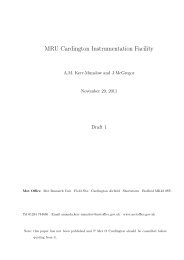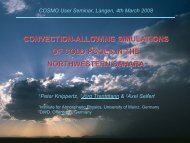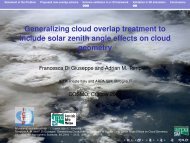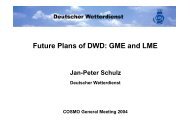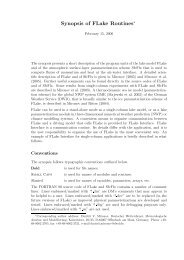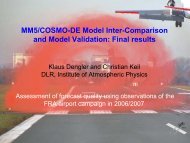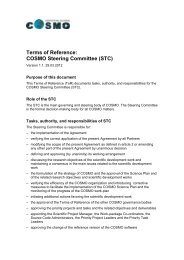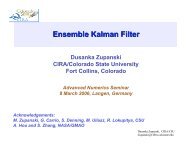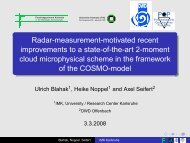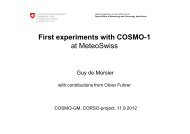document - Cosmo
document - Cosmo
document - Cosmo
Create successful ePaper yourself
Turn your PDF publications into a flip-book with our unique Google optimized e-Paper software.
1 Working Group on Data Assimilation 31<br />
Revised Latent Heat Nudging to cope with Prognostic Precipitation<br />
1 Introduction<br />
Christoph Schraff, Klaus Stephan, and Stefan Klink<br />
Deutscher Wetterdient, Offenbach am Main, Germany<br />
The prognostic treatment of precipitation (Gassmann 2002, Baldauf and Schulz 2004) used<br />
operationally in the LM tends to decorrelate the surface precipitation rate from the vertically<br />
integrated latent heat release and thereby violate the basic assumption of the Latent Heat<br />
Nudging (LHN) approach. This, and resulting problems have been shown by Klink and<br />
Stephan (2005), and they also suggested possible adaptations to the LHN scheme. More<br />
recent experiments have allowed to better specify preferable choices and parameters for at<br />
least some of the adaptations. Here, the specifications for the most important ones are<br />
briefly described, and results of recent experiments are shown. In the concluding remarks,<br />
the current status is summarized, and some remaining problems with LHN are outlined.<br />
2 Major revisions to the LHN scheme<br />
At horizontal model resolutions of 3 km or less, the prognostic treatment of precipitation<br />
allows the model to distinguish between updrafts and downdrafts inside deep convective<br />
systems. Compared to using the diagnostic precipitation scheme, it modifies both the 3-D<br />
spatial structure and the timing of the latent heating with respect to surface precipitation.<br />
Two revisions address spatial aspects and a third one an important temporal issue:<br />
• In updraft regions at the leading edge of convective cells, very high values of latent heat<br />
release ∆TLHmo occur often where precipitation rates RRmo are low. Considering that<br />
∆TLHN = (α − 1) · ∆TLHmo , α = RRobs<br />
RRmo<br />
high values of the scaling factor α and of the latent heat nudging temperature increments<br />
∆TLHN often occur. To mitigate this, the upper limit for α is reduced to<br />
2 and the lower limit increased accordingly to 0.5 . In addition, the linear scaling<br />
(α − 1) is replaced by a logarithmic scaling ln(α) in order to unbias the scheme in<br />
terms of adding or taking away absolute amounts of heat energy. The effective upper<br />
and lower scaling limits are then 1.7 and 0.3 respectively. This adaptation reduces<br />
the simulated precipitation amounts during the LHN.<br />
• In downdraft regions further upstream in convective cells, high precipitation rates occur<br />
often where latent heating is weak or even negative in most vertical layers. In order<br />
to avoid negative LHN temperature increments and cooling where the precipitation<br />
rate should be increased (and vice versa), only the vertical model layers with positive<br />
simulated latent heating are used to compute and insert the LHN increments. These<br />
layers coincide very roughly with the cloudy (saturated) layers. This modification tends<br />
to render the increments more coherent and the scheme more efficient.<br />
COSMO Newsletter No. 6




